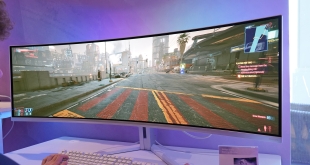The PA238Q uses a 10 bit H-IPS panel which can display 1.07 billion colours. IPS technology allows for 178° viewing angles which will ensure that colour wash and loss is minimal, even when looking at the screen from wide horizontal and vertical angles.
Asus perform individual calibration at the factory to ensure an average delta E factor lower than 5, which in laymans terms means the colour fidelity will be accurate without user intervention. Thankfully, the Asus screen doesn't disappoint in this regard and it demanded very little adjustment from me once it was turned on.
The internal hardware of the PA238Q calls upon the 10 bit colour lookup table to render accurate colours, this is an improvement when compared against the standard 8 bit table used in the ‘average' consumer screen. Colour graduation should be improved, along with accuracy across the gamut. Asus claim a 50,000,000:1 contrast ratio.
IPS panels have been long capable of rendering true 8 bit colour depth which many people will refer to as ’24 bit colour’, this is an 8 bit design on a sub pixel level across the blue, green and red planes. This realistically means that an 8 bit colour depth screen can render the full 16.7 million colours without having to dither the image, which can cause subtle ‘stepping’ of the images.
When looking at other panel technologies such as TN, they are limited to 18 bit colour, or 6 bit colour depth and will use FRC to generate more colours to reach the final 16.2 million scope. In regards to image quality it is clearly apparent that the bit precision of a panel will be directly related to the steps of brightness which are possible.
The more steps, the better the overall image quality, as less apparent stepped banding will be noticeable. Smoother gradients, less banding will result in a higher quality image, especially for people who need critical colour accuracy, such as web designers and photo editing professionals.
While this sounds like everyone should jump immediately into purchasing a more expensive 10 bit IPS panel, in reality it doesn’t always translate into a ‘must have’ situation. People who render images for a living would notice less banding between the 10 bit and 8 bit panels, especially with subtle swatches of constant colour tones. Of course you also have to ensure that the software and complimentary hardware are capable of 10 bit colour and depending on your specific configuration this might not be the case.
This is a prime factor as to why DisplayPort is becoming more and more adopted within the professional industry, because a DVI interface is limited to 24 bit colour. The vast majority of people today will be using DVI, and even aging VGA technology. Some panels even have extended internal processing – 12 bit LUT for instance, which can help improve colour accuracy, but they should really only be used on 10 bit panels, not 8 bit panels.
We are using a LaCie calibration gun along with specific software to measure readings.
We measured Gamut out of the box, and it returned a 2.2 – a perfect result for a computer panel. We changed the gamut to 1.8 and it returned a 1.85 result – not quite as good as the PA246A, but very close. We measured the panel variance and it returned a 14% variance from the center rating of 125 nits. This is not noticeable, and it would be hard to even see with the naked eye.
Colour testing was very positive, measuring almost reference results, much in line with the more expensive PA246Q from May this year. Definition from the colour gamut is top drawer and measured close to the Dell U2410. There was a very minor blue cast across the screen, but this is easy to remove with a very slight adjustment.
As this is an IPS panel, the viewing angles are fantastic, measuring only a slight contrast shift when viewed horizontally from a wide angle. As with the PA246Q, it is basically free from center contrast shifting, a problem often experienced with weaker panel technology.
Black definition is very good, with an overall panel shift of about 8%. There are leaks on all corners, between 12-16%. This is not noticeable under real world situations, although if you have hyper sensitive eyes you might notice it a little on the bottom corners. This is a great result, especially if the focus is on high definition movie playaback.
White purity is excellent, with an overall panel shift around 7-10%. It expands a little at the edges, recording around 13-15%. In real world situations this is not noticeable and overall, it is a good screen for watching movies and for editing images. Again, there is very little colour fluctuation – we measured 1.3% via the B channel.
When gaming, the screen displayed fine characteristics and we didn't notice any lag or abnormalities. That said, it is rated to 6ms, so sensitive individuals might notice minor lag. We tested the panel with 3 or 4 gamers and they didn't notice any problems either, so it looks strong in this regard. An IPS panel such as this which is totally focused on colour rendition and overall accuracy isn't delivering class leading response times, which are 2ms or less.
We measured a power consumption of around 36 watts when using our slightly adjusted ‘user mode' profile. This is a fairly efficient result for an IPS panel, as these tend to consume slightly more power than the ‘average' TN panel.
 KitGuru KitGuru.net – Tech News | Hardware News | Hardware Reviews | IOS | Mobile | Gaming | Graphics Cards
KitGuru KitGuru.net – Tech News | Hardware News | Hardware Reviews | IOS | Mobile | Gaming | Graphics Cards





